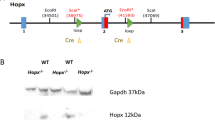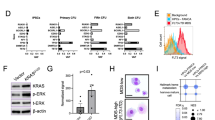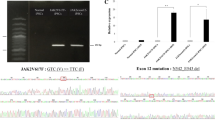Abstract
Somatic mutation of RUNX1 is implicated in various hematological malignancies, including myelodysplastic syndrome and acute myeloid leukemia (AML), and previous studies using mouse models disclosed its critical roles in hematopoiesis. However, the role of RUNX1 in human hematopoiesis has never been tested in experimental settings. Familial platelet disorder (FPD)/AML is an autosomal dominant disorder caused by germline mutation of RUNX1, marked by thrombocytopenia and propensity to acute leukemia. To investigate the physiological function of RUNX1 in human hematopoiesis and pathophysiology of FPD/AML, we derived induced pluripotent stem cells (iPSCs) from three distinct FPD/AML pedigrees (FPD-iPSCs) and examined their defects in hematopoietic differentiation. By in vitro differentiation assays, FPD-iPSCs were clearly defective in the emergence of hematopoietic progenitors and differentiation of megakaryocytes, and overexpression of wild-type (WT)-RUNX1 reversed most of these phenotypes. We further demonstrated that overexpression of mutant-RUNX1 in WT-iPSCs did not recapitulate the phenotype of FPD-iPSCs, showing that the mutations were of loss-of-function type. Taken together, this study demonstrated that haploinsufficient RUNX1 allele imposed cell-intrinsic defects on hematopoietic differentiation in human experimental settings and revealed differential impacts of RUNX1 dosage on human and murine megakaryopoiesis. FPD-iPSCs will be a useful tool to investigate mutant RUNX1-mediated molecular processes in hematopoiesis and leukemogenesis.
This is a preview of subscription content, access via your institution
Access options
Subscribe to this journal
Receive 12 print issues and online access
$259.00 per year
only $21.58 per issue
Buy this article
- Purchase on Springer Link
- Instant access to full article PDF
Prices may be subject to local taxes which are calculated during checkout








Similar content being viewed by others
References
Ichikawa M, Asai T, Saito T, Seo S, Yamazaki I, Yamagata T et al. AML-1 is required for megakaryocytic maturation and lymphocytic differentiation, but not for maintenance of hematopoietic stem cells in adult hematopoiesis. Nat Med 2004; 10: 299–304.
Osato M . Point mutations in the RUNX1/AML1 gene: another actor in RUNX leukemia. Oncogene 2004; 23: 4284–4296.
Harada H, Harada Y, Niimi H, Kyo T, Kimura A, Inaba T . High incidence of somatic mutations in the AML1/RUNX1 gene in myelodysplastic syndrome and low blast percentage myeloid leukemia with myelodysplasia. Blood 2004; 103: 2316–2324.
Christiansen DH, Andersen MK, Pedersen-Bjergaard J . Mutations of AML1 are common in therapy-related myelodysplasia following therapy with alkylating agents and are significantly associated with deletion or loss of chromosome arm 7q and with subsequent leukemic transformation. Blood 2004; 104: 1474–1481.
Harada H, Harada Y, Tanaka H, Kimura A, Inaba T . Implications of somatic mutations in the AML1 gene in radiation-associated and therapy-related myelodysplastic syndrome/acute myeloid leukemia. Blood 2003; 101: 673–680.
Zharlyganova D, Harada H, Harada Y, Shinkarev S, Zhumadilov Z, Zhunusova A et al. High frequency of AML1/RUNX1 point mutations in radiation-associated myelodysplastic syndrome around Semipalatinsk nuclear test site. J Radiat Res 2008; 49: 549–555.
Kuo MC, Liang DC, Huang CF, Shih YS, Wu JH, Lin TL et al. RUNX1 mutations are frequent in chronic myelomonocytic leukemia and mutations at the C-terminal region might predict acute myeloid leukemia transformation. Leukemia 2009; 23: 1426–1431.
Ernst T, Chase A, Zoi K, Waghorn K, Hidalgo-Curtis C, Score J et al. Transcription factor mutations in myelodysplastic/myeloproliferative neoplasms. Haematologica 2010; 95: 1473–1480.
Matheny CJ, Speck ME, Cushing PR, Zhou Y, Corpora T, Regan M et al. Disease mutations in RUNX1 and RUNX2 create nonfunctional, dominant-negative, or hypomorphic alleles. EMBO J 2007; 26: 1163–1175.
Harada Y, Harada H . Molecular pathways mediating MDS/AML with focus on AML1/RUNX1 point mutations. J Cell Physiol 2009; 220: 16–20.
Michaud J, Wu F, Osato M, Cottles GM, Yanagida M, Asou N et al. In vitro analyses of known and novel RUNX1/AML1 mutations in dominant familial platelet disorder with predisposition to acute myelogenous leukemia: implications for mechanisms of pathogenesis. Blood 2002; 99: 1364–1372.
Imai Y, Kurokawa M, Izutsu K, Hangaishi A, Takeuchi K, Maki K et al. Mutations of the AML1 gene in myelodysplastic syndrome and their functional implications in leukemogenesis. Blood 2000; 96: 3154–3160.
Song WJ, Sullivan MG, Legare RD, Hutchings S, Tan X, Kufrin D et al. Haploinsufficiency of CBFA2 causes familial thrombocytopenia with propensity to develop acute myelogenous leukaemia. Nat Genet 1999; 23: 166–175.
Higuchi M, O'Brien D, Kumaravelu P, Lenny N, Yeoh EJ, Downing JR . Expression of a conditional AML1-ETO oncogene bypasses embryonic lethality and establishes a murine model of human t(8;21) acute myeloid leukemia. Cancer Cell 2002; 1: 63–74.
Motoda L, Osato M, Yamashita N, Jacob B, Chen LQ, Yanagida M et al. Runx1 protects hematopoietic stem/progenitor cells from oncogenic insult. Stem Cells 2007; 25: 2976–2986.
Jacob B, Osato M, Yamashita N, Wang CQ, Taniuchi I, Littman DR et al. Stem cell exhaustion due to Runx1 deficiency is prevented by Evi5 activation in leukemogenesis. Blood 2010; 115: 1610–1620.
Takahashi K, Tanabe K, Ohnuki M, Narita M, Ichisaka T, Tomoda K et al. Induction of pluripotent stem cells from adult human fibroblasts by defined factors. Cell 2007; 131: 861–872.
Yu J, Vodyanik MA, Smuga-Otto K, Antosiewicz-Bourget J, Frane JL, Tian S et al. Induced pluripotent stem cell lines derived from human somatic cells. Science 2007; 318: 1917–1920.
Chou ST, Byrska-Bishop M, Tober JM, Yao Y, Vandorn D, Opalinska JB et al. Trisomy 21-associated defects in human primitive hematopoiesis revealed through induced pluripotent stem cells. Proc Natl Acad Sci USA 2012; 109: 17573–17578.
Ye Z, Zhan H, Mali P, Dowey S, Williams DM, Jang YY et al. Human-induced pluripotent stem cells from blood cells of healthy donors and patients with acquired blood disorders. Blood 2009; 114: 5473–5480.
Park IH, Arora N, Huo H, Maherali N, Ahfeldt T, Shimamura A et al. Disease-specific induced pluripotent stem cells. Cell 2008; 134: 877–886.
Hiramoto T, Ebihara Y, Mizoguchi Y, Nakamura K, Yamaguchi K, Ueno K et al. Wnt3a stimulates maturation of impaired neutrophils developed from severe congenital neutropenia patient-derived pluripotent stem cells. Proc Natl Acad Sci USA 2013; 110: 3023–3028.
Maclean GA, Menne TF, Guo G, Sanchez DJ, Park IH, Daley GQ et al. Altered hematopoiesis in trisomy 21 as revealed through in vitro differentiation of isogenic human pluripotent cells. Proc Natl Acad Sci USA 2012; 109: 17567–17572.
Chang CJ, Bouhassira EE . Zinc-finger nuclease-mediated correction of alpha-thalassemia in iPS cells. Blood 2012; 120: 3906–3914.
Carette JE, Pruszak J, Varadarajan M, Blomen VA, Gokhale S, Camargo FD et al. Generation of iPSCs from cultured human malignant cells. Blood 2010; 115: 4039–4042.
Kumano K, Arai S, Hosoi M, Taoka K, Takayama N, Otsu M et al. Generation of induced pluripotent stem cells from primary chronic myelogenous leukemia patient samples. Blood 2012; 119: 6234–6242.
Gandre-Babbe S, Paluru P, Aribeana C, Chou ST, Bresolin S, Lu L et al. Patient-derived induced pluripotent stem cells recapitulate hematopoietic abnormalities of juvenile myelomonocytic leukemia. Blood 2013; 121: 4925–4929.
Seki T, Yuasa S, Fukuda K . Generation of induced pluripotent stem cells from a small amount of human peripheral blood using a combination of activated T cells and Sendai virus. Nat Protoc 2012; 7: 718–728.
Fukuchi Y, Shibata F, Ito M, Goto-Koshino Y, Sotomaru Y, Ito M et al. Comprehensive analysis of myeloid lineage conversion using mice expressing an inducible form of C/EBP alpha. EMBO J 2006; 25: 3398–3410.
Ma F, Wang D, Hanada S, Ebihara Y, Kawasaki H, Zaike Y et al. Novel method for efficient production of multipotential hematopoietic progenitors from human embryonic stem cells. Int J Hematol 2007; 85: 371–379.
Ma F, Ebihara Y, Umeda K, Sakai H, Hanada S, Zhang H et al. Generation of functional erythrocytes from human embryonic stem cell-derived definitive hematopoiesis. Proc Natl Acad Sci USA 2008; 105: 13087–13092.
Takayama N, Nishikii H, Usui J, Tsukui H, Sawaguchi A, Hiroyama T et al. Generation of functional platelets from human embryonic stem cells in vitro via ES-sacs, VEGF-promoted structures that concentrate hematopoietic progenitors. Blood 2008; 111: 5298–5306.
Nakajima H, Ito M, Smookler DS, Shibata F, Fukuchi Y, Morikawa Y et al. TIMP-3 recruits quiescent hematopoietic stem cells into active cell cycle and expands multipotent progenitor pool. Blood 2010; 116: 4474–4482.
Seki T, Yuasa S, Oda M, Egashira T, Yae K, Kusumoto D et al. Generation of induced pluripotent stem cells from human terminally differentiated circulating T cells. Cell Stem Cell 2010; 7: 11–14.
Xu MJ, Tsuji K, Ueda T, Mukouyama YS, Hara T, Yang FC et al. Stimulation of mouse and human primitive hematopoiesis by murine embryonic aorta-gonad-mesonephros-derived stromal cell lines. Blood 1998; 92: 2032–2040.
Vodyanik MA, Thomson JA, Slukvin II . Leukosialin (CD43) defines hematopoietic progenitors in human embryonic stem cell differentiation cultures. Blood 2006; 108: 2095–2105.
Choi KD, Yu J, Smuga-Otto K, Salvagiotto G, Rehrauer W, Vodyanik M et al. Hematopoietic and endothelial differentiation of human induced pluripotent stem cells. Stem Cells 2009; 27: 559–567.
Dowdy CR, Xie R, Frederick D, Hussain S, Zaidi SK, Vradii D et al. Definitive hematopoiesis requires Runx1 C-terminal-mediated subnuclear targeting and transactivation. Hum Mol Genet 2010; 19: 1048–1057.
Okuda T, van Deursen J, Hiebert SW, Grosveld G, Downing JR . AML1 the target of multiple chromosomal translocations in human leukemia, is essential for normal fetal liver hematopoiesis. Cell 1996; 84: 321–330.
Wang Q, Stacy T, Binder M, Marin-Padilla M, Sharpe AH, Speck NA . Disruption of the Cbfa2 gene causes necrosis and hemorrhaging in the central nervous system and blocks definitive hematopoiesis. Proc Natl Acad Sci USA 1996; 93: 3444–3449.
North T, Gu TL, Stacy T, Wang Q, Howard L, Binder M et al. Cbfa2 is required for the formation of intra-aortic hematopoietic clusters. Development 1999; 126: 2563–2575.
North TE, de Bruijn MF, Stacy T, Talebian L, Lind E, Robin C et al. Runx1 expression marks long-term repopulating hematopoietic stem cells in the midgestation mouse embryo. Immunity 2002; 16: 661–672.
Lancrin C, Sroczynska P, Stephenson C, Allen T, Kouskoff V, Lacaud G . The haemangioblast generates haematopoietic cells through a haemogenic endothelium stage. Nature 2009; 457: 892–895.
Chen MJ, Yokomizo T, Zeigler BM, Dzierzak E, Speck NA . Runx1 is required for the endothelial to haematopoietic cell transition but not thereafter. Nature 2009; 457: 887–891.
Ran D, Shia WJ, Lo MC, Fan JB, Knorr DA, Ferrell PI et al. RUNX1a enhances hematopoietic lineage commitment from human embryonic stem cells and inducible pluripotent stem cells. Blood 2013; 121: 2882–2890.
Acknowledgements
We thank excellent technical assistance by J Kawakita. We also thank S Suzuki (FACS Core Laboratory, Keio University School of Medicine) for FACS sorting, W Akamatsu and M Sato (Department of Physiology, Keio University School of Medicine) and H Nakata (Division of Cardiology, Keio University School of Medicine) for cell culture or establishment of iPSCs. This work was supported in part by a grant from the Ministry of Education, Culture, Sports, Science and Technology of Japan.
Author information
Authors and Affiliations
Corresponding author
Ethics declarations
Competing interests
HO is the scientific consultant of San Bio, Inc., Eisai Co Ltd. and Daiichi Sankyo Co Ltd. HN is a founder, a member of scientific advisory board and shareholder of ReproCELL and is a scientific advisor of Megakaryon, iCELL and Shionogi & Co. The remaining authors declare no conflict of interest.
Additional information
Supplementary Information accompanies this paper on the Leukemia website
Supplementary information
Rights and permissions
About this article
Cite this article
Sakurai, M., Kunimoto, H., Watanabe, N. et al. Impaired hematopoietic differentiation of RUNX1-mutated induced pluripotent stem cells derived from FPD/AML patients. Leukemia 28, 2344–2354 (2014). https://doi.org/10.1038/leu.2014.136
Received:
Revised:
Accepted:
Published:
Issue Date:
DOI: https://doi.org/10.1038/leu.2014.136
This article is cited by
-
Germline RUNX1 translocation in familial platelet disorder with propensity to myeloid malignancies
Annals of Hematology (2022)
-
The mutual regulatory loop between TPTEP1 and miR-1303 in leukemogenesis of acute myeloid leukemia
Cancer Cell International (2021)
-
Differentiation of human induced pluripotent stem cells into erythroid cells
Stem Cell Research & Therapy (2020)
-
MiR-194 targets Runx1/Akt pathway to reduce renal fibrosis in mice with unilateral ureteral obstruction
International Urology and Nephrology (2020)
-
Preleukemic and second-hit mutational events in an acute myeloid leukemia patient with a novel germline RUNX1 mutation
Biomarker Research (2018)



